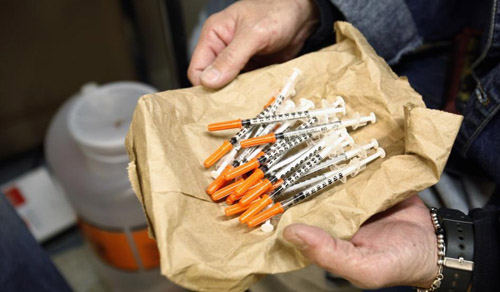
In one of its final acts of 2015, Congress quietly lifted the longstanding ban on federal funding for syringe services programs (SSPs)—but not entirely. The measure, which was included in an omnibus spending bill passed in December, allows states and local communities to use federal funds to pay for all operational costs at SSPs. But in a huge irony that speaks to the continuing staunch opposition to syringe exchange on the part of many lawmakers, the funds cannot be used to pay for the syringes themselves. At pennies per unit, syringes are a small part of most SSP budgets, and the change should allow the much-needed programs to emerge in certain areas of the U.S. where they are currently sparse or absent.
“This is fantastic news, but there is still more that needs to be done,” says Greg Millett, amfAR vice president and director of Public Policy. “The legislation only allows for funds to be used if there is evidence of a current or impending infectious disease outbreak. SSPs should be standard public health practice as a preventative measure without restrictions, and not only as a fallback tool to use after an increase in hepatitis C or HIV diagnoses.”
The partial repeal was reportedly spearheaded by Republican Congressional leaders from Kentucky, and it follows an unprecedented HIV outbreak last summer among injection drug users in neighboring Scott County, Indiana, and a decision by Kentucky to implement SSPs for the first time.
Currently, injection drug use—both heroin and prescription opioids—is surging across America, particularly in rural areas like Scott County without access to SSPs, leading to an alarming increase in HIV and hepatitis C infections. According to the CDC, unsafe injection drug use has contributed to a 150% increase in acute cases of hepatitis C in recent years, and Kentucky has the nation’s highest rates of hepatitis C cases.
Scientific evidence demonstrates that SSPs are highly effective at reducing the transmission of HIV and other blood-borne diseases among people who inject drugs (PWID) without increasing drug use. They also increase public safety and help link PWID to needed health services, including HIV and hepatitis C care, substance abuse treatment, and overdose prevention. And they are extremely cost effective, averting millions of dollars in HIV and hepatitis C treatment costs.
In areas where SSPs were implemented before HIV emerged among the PWID population, HIV prevalence has generally remained below 5%. By contrast, in New York City, the rate among the population climbed to 54% before the introduction of SSPs in the early 1990s. Thanks to SSPs and other prevention measures, it had fallen to 13% by 2001 and is now down to less than 1%. According to amfAR’s 2015 issue brief, “Preventing HIV and Hepatitis C Among People Who Inject Drugs: Public Funding for Syringe Services Programs Makes the Difference,” the number of new HIV diagnoses in Scott County, Indiana, (population 24,000) in the first few months of 2015 alone was more than triple the number of new HIV diagnoses among the estimated 100,000 PWID in New York City in all of 2013.
“Outbreaks in Indiana and elsewhere have been powerful reminders that PWID can be at very high risk for HIV and hepatitis C,” said Dr. Jonathan Mermin, director of the CDC’s National Center for HIV/AIDS, Viral Hepatitis, STD, and TB Prevention, in a statement on the CDC’s website. “The CDC has historically recommended that states ensure PWID have access to integrated prevention services from a reliable source. Congress’s decision makes that job easier.”
For more information on the need for SSPs, visit www.amfar.org/endtheban.
Read More: